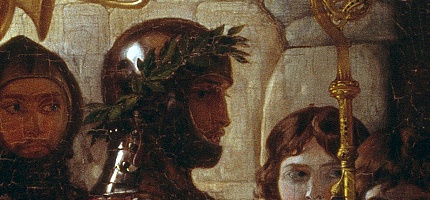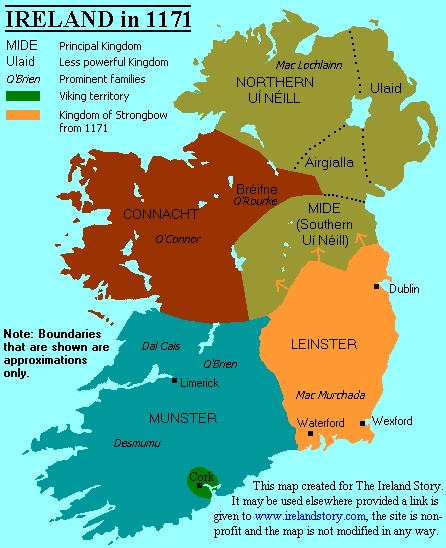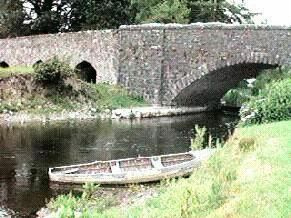Norman Ireland
This section is taken with appreciation from the book A History of Ireland by Peter and Fiona Somerset Fry.
After the death of Brian Boroime (Boru) in 1014 at the battle of Clontarf no other high king had the strength to unify Ireland which fell into violence and disorder. Alliances shifted, hostages were given and seized, fierce rivalries broke out, churches and homesteads were burned, and men from the different kingdoms fought and raided one another. In 1151, in the midst of all the turmoil, an event of apparent insignificance took ace.Diarmait Mac Murchada, the king of Leinster, carried off the wife of Tigernan Ua Ruairk, the king of Breifne (where Cavan and Leitrim are now). The next year Derbforgaill was back under her husband’s roof; a trivial escapade seemed to be over; but as a result of it, everything was to change.
Tigernan could not forgive the insult he had suffered. He conceived an implacable hatred of the younger Diarmait and years later, in 1166, he saw his chance for revenge. Diarmait had allied himself with MuirchertachMac Lochlainn, who had earned the revulsion of the Irish kings and chieftains by treacherously blinding the king of Ulidia, although he had already submitted to Muirchertach and had his submission guaranteed by other princes. In the furor that followed, Toirrdelbach’s son Ruadri Ua Conchobair won the high kingship, Diarmait Mac Murchada lost his patron, Tigernan attached him, the Ostmen of Dublin and various Leinster chieftains, who normally supported him, joined in the attach and Diarmait was, in effect, driven out of his kingdom. On 1st August 1166 he took the step which has blackened his name forever. Taking his marriageable daughterAife with him, he sailed to the port of Bristol, which was already familiar to him, to seek the aid, in the form of an army, of Henry II of England.
Henry (a Frenchman) was not only king of England; he ruled more of France, including Normandy, than the French king himself, and it was in early 1167 when Diarmait came up with him in Aquitaine. Henry greeted him with his usual bluff amiability, made him gifts and, in return for Diarmait’s allegiance, gave him permission to recruit help from among his barons. Henry could not lose by the arrangement. He had not promised to help Diarmait personally, but if Diarmait found enough support among Henry’s vassals to win his kingdom of Leinster back, Henry, as his overlord, would have a foothold in Ireland. He gave Diarmait an open letter, addressed to “all his liegemen, English, Normans, Welsh and Scots’, which read: “know you that we have taken Diarmait, prince of the men of Leinster, into the bosom of our grace and goodwill. Wherefore, too, whosoever within the bounds of our dominions shall be willing to lend him aid, as being our vassal and liegeman, in the recovery of his own, let him know that he has our favour and permission to that end.”
Diarmait went back to Bristol and looked for help. He had Henry’s letter read out in public several times, and made liberal offers of land and bounty. For a while, there was no response. Then Richard Fitzgilbert de Clare, the Norman earl of Pembroke, generally known as Strongbow, came forward. He was out of favour at court, restless, discontented, and eager for an adventure like the Irish one. He obtained Henry’s written consent to it, Diarmait offered him the hand of his daughter Aife in marriage and the deal was done. Next, Diarmait went into South Wales to recruit the help of Strongbow’s kinsmen, the Geraldines.
Diarmait did not wait for his Norman supporters. Taking a handful of mercenaries with him, he sailed for Ireland in the autumn of 1167 and lay low in a monastery at his capital, Ferns, for the winter when he was not being attacked
by Tigernan or the high king until 1169 when a further 40 knights and 400 archer mercenaries came to his support. Diarmait recovered his lands and made peace with the high king. Once he was re-established as the king of Leinster Diarmait had
aspired to the high kingship himself. He was still owed help by his daughter’s betrothed, Strongbow, and wrote to the Welsh-Norman earl in 1170 reminding him of his two-year-old promise. Strongbow sent Raymond Le Gros, one of the Geraldines,
ahead of him with about ninety men who ruthlessly defeated about 2,000 Ostmen and Irish from Munster after landing at Baginbun in Wexford. At the last moment, when Strongbow, was about to embark, messengers came from Henry forbidding
the expedition. Too late -
Strongbow had made his plans, collected his men and set sail for Ireland. Two hundred knights and a thousand archers took ship with him at Milford Haven and landed near Waterford on 23rd August, an
event described prophetically in the Irish Annals of Ulster as ‘the beginning of the woes of Ireland”. Two days later, aided by Raymond, he took Waterford by assault. Diarmait brought Aifa to him and their marriage was solemnized
in Waterford cathedral.
Diarmait led Strongbow and his army to Dublin where they stormed the city, defeating the high king who left the most important town in Ireland to its fate. Then in May 1171 Diarmait died, aged 61, at Ferns. WhenDiarmait betrothed his daughter Aifa to Strongbow, he may, or may not, have promised Strongbow that he could inherit the kingdom of Leinster after his death. Under the feudal law of the Normans, such an inheritance would have been perfectly possible, and Strongbow assumed the kingship. But a king could not name his successor under Irish law. When a king died, his successor had to be elected from amongst eligible members of the royal family, ‘a stranger in sovereignty’ was unacceptable and the succession could never pass through a woman. Diarmait had no eligible sons left, both having been killed. But he did have a nephew,Muirchertach, and the people of Leinster rallied to him.
Muirchertach, the high king, Ruaidri and kings from all over Ireland were by now seriously alarmed by the presence of the Normans and formed an army of perhaps 30,000 to bring against them. The Irish were brave but indolent soldiers who wore no armour and fought as a horde, in disarray. They surrounded the city of Dublin and prepared to starve the Norman forces of no more than 200 knights, 400 other mounted men and 1,500 archers and foot soldiers into submission. But the Normans had the most advanced military techniques in Europe, were highly trained, and equipped with the latest weapons and amour. After two months had passed some 600 of the Normans slipped out and of the city into three divisions, spread out and attached the flank of the Irish army. The Irish were completely taken by surprise; the high king and some hundreds of his followers were caught bathing in the river. The great besieging army was totally routed.
Henry II watched these events with some anxiety. Strongbow was too successful, suppose he was to conquer Ireland, become high king and abandon his allegiance, leaving a strong Norman led kingdom off the Welsh coast treathing his empire. Henry assembled an impressive force, with 500 knights and about 3,000 archers, portable wooden towers for sieges and castle building, and vast quantities of provisions, and then summoned Strongbow to him. Strongbow obeyed the summons and renewed his oath of fealty. Henry took the best of Strongbow’s conquest - Dublin, the eastern coastal strip and all the coastal towns and fortresses – and confirmed Strongbow in possession of Leinster. He then set sail for Ireland with his army to claim the homage of all the kings and chieftains of Ireland.
Before leaving Ireland Henry appointed Hugh de Lacy, another Norman baron from Wales, who had come over in his train, to be his justiciary, or chief officer, in Ireland, to counterbalance the power of Strongbow, whom he still did not trust, waited for a favourable wind and then, on 17th April 1172, took ship at Wexford and sailed away. De Lacy was granted the kingdom of Meath.
One hundred years earlier, England had been conquered by the Normans, aggressive cousins of those Vikings who had made such inroads into Ireland. The Normans had been Northmen, that is, Scandinavians, mainly from Norway, whose hunger for new lands and opportunities had led them, in the ninth and tenth centuries, to northern France where they had wrested a duchy from the native aristocracy and then adopted the French language, manners and customs.
The Bridge Of Finea
In the ancient Irish legend the Tain, a Connaught army marched from Rathcrogan in Co Roscommon, to steal a bull from Ulster. They marched to Granard, Co Longford and then turned south-west heading for Crossakiel in Co Meath. This route would have brought them through Finea. They were not the first army to march through Finea, and many more armies followed them.
Before the road building schemes of the last 200 years, the boglands that lie along the Inny on its course from Sheelin to Derravaragh, were an impassable wilderness. The two lakes formed the ends of an impregnable natural defence line. Any army that found itself faced with this obstacle, had to go around it, or storm Finea. North of Finea, the Erne provided a similar natural obstacle and control of Finea was the key to controlling a lot of south Cavan.
Fiodh an Atha, means the wood of the ford, which may mean a ford surrounded by trees, or a ford made of wood, perhaps of wooden hurdles. In the late 1100s or early 1200s Finea was seized by the Norman de Tuite family, who held it for at least 150 years. It was an important tactical point between Norman Meath and Longford. Prince John, marched through on the 12th of August 1210. John was known as the bridge building King, and the medieval core of the modern bridge probably dates from shortly after his visit.
In 1315 Edward the Bruce burned “the English Town of Finea”. The Clan Mahon O’Reillys destroyed the castle, which stood on the south bank of the river, to the east of the road. It was repaired in 1397 by Edward Mortimer, Earl of March. Richard Nugent, 13th Baron of Delvin, was killed in a skirmish nearby in 1559. Christopher his son, 14th Baron, placed a garrison there in the nine year war (1594-1603), and for his loyal service to Queen Elizabeth was granted lands in Cavan. James Nugent, nephew of the 14th Baron, was Confederate Governor of Fineain the 12 year war (1641-53).
In 1644 Confederate forces clashed with Munro’s Scottish army near the bridge. In 1651 Cromwellian forces began the invasion of Cavan by storming Finea.
Published by: Local Ireland
Year written: 1993
Copyright owned by: Kevin Sweeney
The Parish Of Mountnugent
The parish of Mountnugent extends along the eastern shore of Lough Sheelin. It was originally called Kilbride, the name is derived from an early Christian church site. All that now remains of the site is a disused graveyard. It is part of the diocese of Meath, and the Barony of Clonmahon. In the pre-modern era, Mountnugent was part of Maigh Maine, an area extending from Lough Sheelin to the Lough Crew hills (or in Irish 'Sliabh na Caillighe', the hill of the witch) in County Meath.
Meath was granted to Hugh de Lacy by King Henry 2nd in 1172. Hugh granted a strip of land along the Meath, Cavan, Longford border to his follower Richard de Tuite. He build several mottes in the region, including Racraveen, a mile north of the modern village of Mountnugent. The de Tuites lost these lands in the 1300’s to the Clan O'Reillys, who built Crover castle in nearby Ballymachugh. The O'Reillys pushed the frontier deep into modern Co. Meath, and kept it there until 1505, when they lost the land in Meath to the Anglo Norman Plunkett family from Lough Crew. The senior branch of the O'Reillys also took land away from their Clan Mahon cousins, and by the late 1500s the principal O'Reilly seat in the area was Kilnacrott castle. Edmund O'Reilly of Kilnacrott was the last man to be chief of Brefnie.
After the Plantation of Ulster the Nugents owned most of the land in the parish. The Lambert family were granted land in the parish during the plantation. But they mortgaged their lands and within two generations, they were practically broke, in spite of holding the title "Earl of Cavan". Brigadier General Oliver Nugent, who commanded the famous 36th Ulster Division at the battle of the Somme in 1916, was a Mountnugent man.
Published by: Local Ireland
Copyright owned by: Kevin Sweeney
Granard
This busy market town, in the east of County Longford, is a popular centre for fishermen seeking perch, pike, roach and tench on the nearby lakes of Gowna, Kinale and Sheelin and the Inny River which runs through here and holds trout. Fans of Mother Nature will also delight in the beautiful creeping willow, hedge mustard and wild pansys that grow wild here. Two rare plants - bedstraw and stonecrop – have been found on the motte itself. At the south-western end of town, the Moat of Granard is Ireland's highest motte, at 534 foot. During their first decades in Ireland, the Anglo- Norman's felt control of Granard was essential to securing the northern marches of Leinster against the Gaelic chieftains, and in about 1200 AD, they built the motte here on a site believed to have been the royal residence of Cairbre, eldest son of Niall of the Nine Hostages, during the 5th century. When the O'Farrell chieftain refused to give Edward the Bruce's invading Scots army shelter during the cold winter months of 1315, Bruce had the town sacked and burned. In 1798, a group of insurgents who had fled to Granard in order to regroup were surprised by the English and defeated - many of the prisoners taken were executed on the spot which. during the War of Independence (1919 - 1921), Granard again became a scene of confrontation.
Abbeylara Village, on the banks of Lough Kinale (trout), famous for a 13th century abbey founded by Anglo-Norman Richard Tuite which, though plundered by Edward the Bruce's forces after the sack of Granard in 1315, survived until the Dissolution. Two of its abbots became bishops of Clonmacnoise. St. Patrick is said to have founded a church north of the village in 460 AD – a semi-circular earthwork which still survives. The Black Pig's Race, another massive ancient earthwork, stretches some 6 miles along the shore of Lough Kinale.


